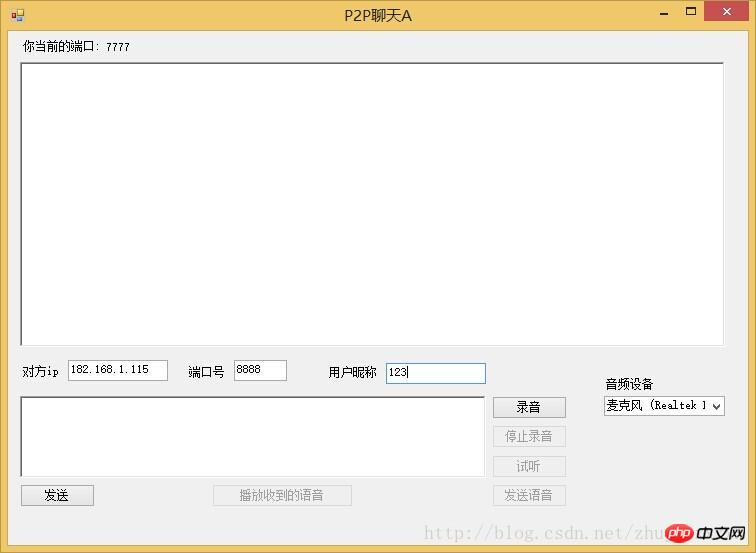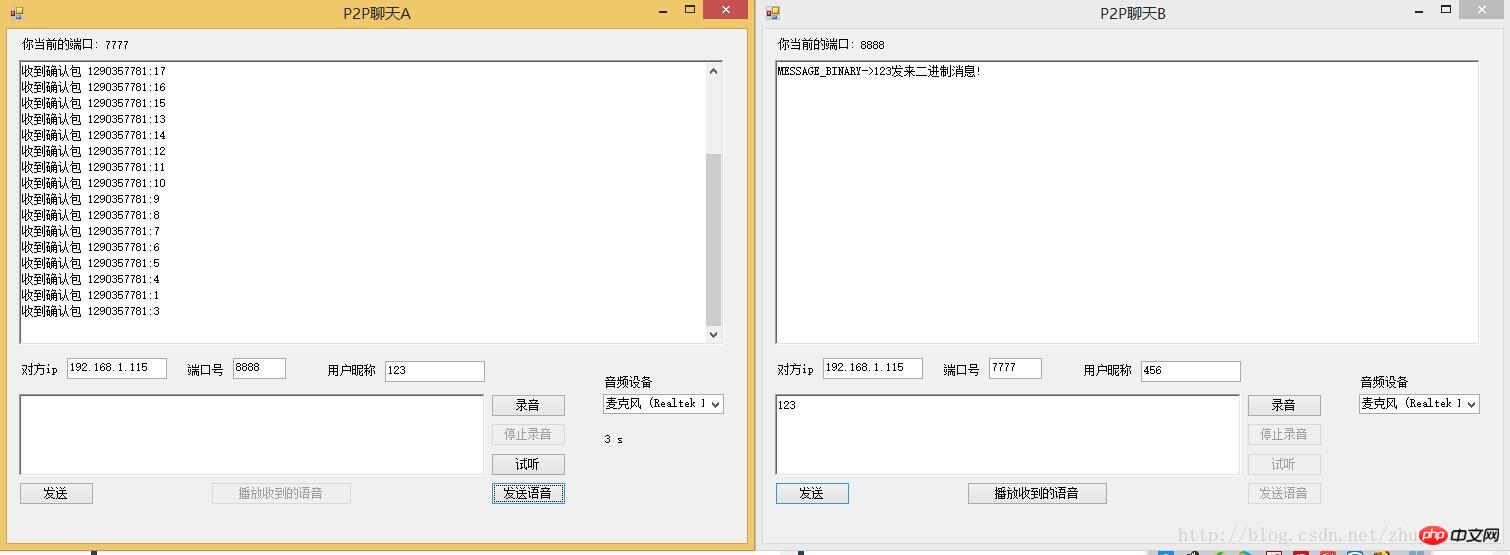c#基於udp實現的p2p語音聊天工具
- 黄舟原創
- 2018-05-16 16:45:012845瀏覽
原創性申明
此部落格的來源為 http://www.php.cn/如果進行轉載請註明出處。本文作者原創,信箱zhujunxxxxx@163.com,如有問題請聯絡作者
#概述
之前曾經發過文章http://www.php.cn/ #已經實現過了UDP的分包發送資料的功能,而這篇文章主要是一個應用,使用udp傳送語音和文字等資訊。在這個系統中沒有服務端和客戶端,相互通訊都是直接相互連結的。能夠很好的實現效果。
語音取得
要想傳送語音訊息,首先得獲取語音,這裡有幾種方法,一種是使用DirectX的DirectXsound來錄音,我為了簡單使用一個開源的插件NAudio來實現語音錄取。 在專案中引用NAudio.dll#
//------------------录音相关-----------------------------
private IWaveIn waveIn;
private WaveFileWriter writer;
private void LoadWasapiDevicesCombo()
{
var deviceEnum = new MMDeviceEnumerator();
var devices = deviceEnum.EnumerateAudioEndPoints(DataFlow.Capture, DeviceState.Active).ToList();
comboBox1.DataSource = devices;
comboBox1.DisplayMember = "FriendlyName";
}
private void CreateWaveInDevice()
{
waveIn = new WaveIn();
waveIn.WaveFormat = new WaveFormat(8000, 1);
waveIn.DataAvailable += OnDataAvailable;
waveIn.RecordingStopped += OnRecordingStopped;
}
void OnDataAvailable(object sender, WaveInEventArgs e)
{
if (this.InvokeRequired)
{
this.BeginInvoke(new EventHandler<WaveInEventArgs>(OnDataAvailable), sender, e);
}
else
{
writer.Write(e.Buffer, 0, e.BytesRecorded);
int secondsRecorded = (int)(writer.Length / writer.WaveFormat.AverageBytesPerSecond);
if (secondsRecorded >= 10)//最大10s
{
StopRecord();
}
else
{
l_sound.Text = secondsRecorded + " s";
}
}
}
void OnRecordingStopped(object sender, StoppedEventArgs e)
{
if (InvokeRequired)
{
BeginInvoke(new EventHandler<StoppedEventArgs>(OnRecordingStopped), sender, e);
}
else
{
FinalizeWaveFile();
}
}
void StopRecord()
{
AllChangeBtn(btn_luyin, true);
AllChangeBtn(btn_stop, false);
AllChangeBtn(btn_sendsound, true);
AllChangeBtn(btn_play, true);
//btn_luyin.Enabled = true;
//btn_stop.Enabled = false;
//btn_sendsound.Enabled = true;
//btn_play.Enabled = true;
if (waveIn != null)
waveIn.StopRecording();
//Cleanup();
}
private void Cleanup()
{
if (waveIn != null)
{
waveIn.Dispose();
waveIn = null;
}
FinalizeWaveFile();
}
private void FinalizeWaveFile()
{
if (writer != null)
{
writer.Dispose();
writer = null;
}
}
//开始录音
private void btn_luyin_Click(object sender, EventArgs e)
{
btn_stop.Enabled = true;
btn_luyin.Enabled = false;
if (waveIn == null)
{
CreateWaveInDevice();
}
if (File.Exists(soundfile))
{
File.Delete(soundfile);
}
writer = new WaveFileWriter(soundfile, waveIn.WaveFormat);
waveIn.StartRecording();
}上面的程式碼實作了錄音,並且寫入檔案p2psound_A.wav
語音傳送
取得到語音後我們要把語音傳送出去
當我們錄好音後點擊發送,這部分相關程式碼是
MsgTranslator tran = null;
public Form1()
{
InitializeComponent();
LoadWasapiDevicesCombo();//显示音频设备
Config cfg = SeiClient.GetDefaultConfig();
cfg.Port = 7777;
UDPThread udp = new UDPThread(cfg);
tran = new MsgTranslator(udp, cfg);
tran.MessageReceived += tran_MessageReceived;
tran.Debuged += new EventHandler<DebugEventArgs>(tran_Debuged);
}
private void btn_sendsound_Click(object sender, EventArgs e)
{
if (t_ip.Text == "")
{
MessageBox.Show("请输入ip");
return;
}
if (t_port.Text == "")
{
MessageBox.Show("请输入端口号");
return;
}
string ip = t_ip.Text;
int port = int.Parse(t_port.Text);
string nick = t_nick.Text;
string msg = "语音消息";
IPEndPoint remote = new IPEndPoint(IPAddress.Parse(ip), port);
Msg m = new Msg(remote, "zz", nick, Commands.SendMsg, msg, "Come From A");
m.IsRequireReceive = true;
m.ExtendMessageBytes = FileContent(soundfile);
m.PackageNo = Msg.GetRandomNumber();
m.Type = Consts.MESSAGE_BINARY;
tran.Send(m);
}
private byte[] FileContent(string fileName)
{
FileStream fs = new FileStream(fileName, FileMode.Open, FileAccess.Read);
try
{
byte[] buffur = new byte[fs.Length];
fs.Read(buffur, 0, (int)fs.Length);
return buffur;
}
catch (Exception ex)
{
return null;
}
finally
{
if (fs != null)
{
//关闭资源
fs.Close();
}
}
}
語音的接收與播放
#其實語音的接收與文字訊息的接收沒有什麼不同,只不過語音發送的時候是以二進制發送的,因此我們在收到語音後就應該寫入到一個文件裡面去,接收完成後,播放這段語音就行了。
下面這段程式碼主要是把收到的資料保存到檔案中去,這個函數式我的NetFrame裡收到訊息時所觸發的事件,在文章前面提過的那篇文章裡
void tran_MessageReceived(object sender, MessageEventArgs e)
{
Msg msg = e.msg;
if (msg.Type == Consts.MESSAGE_BINARY)
{
string m = msg.Type + "->" + msg.UserName + "发来二进制消息!";
AddServerMessage(m);
if (File.Exists(recive_soundfile))
{
File.Delete(recive_soundfile);
}
FileStream fs = new FileStream(recive_soundfile, FileMode.Create, FileAccess.Write);
fs.Write(msg.ExtendMessageBytes, 0, msg.ExtendMessageBytes.Length);
fs.Close();
//play_sound(recive_soundfile);
ChangeBtn(true);
}
else
{
string m = msg.Type + "->" + msg.UserName + "说:" + msg.NormalMsg;
AddServerMessage(m);
}
}
//--------播放部分----------
private IWavePlayer wavePlayer;
private WaveStream reader;
public void play_sound(string filename)
{
if (wavePlayer != null)
{
wavePlayer.Dispose();
wavePlayer = null;
}
if (reader != null)
{
reader.Dispose();
}
reader = new MediaFoundationReader(filename, new MediaFoundationReader.MediaFoundationReaderSettings() { SingleReaderObject = true });
if (wavePlayer == null)
{
wavePlayer = new WaveOut();
wavePlayer.PlaybackStopped += WavePlayerOnPlaybackStopped;
wavePlayer.Init(reader);
}
wavePlayer.Play();
}
private void WavePlayerOnPlaybackStopped(object sender, StoppedEventArgs stoppedEventArgs)
{
if (stoppedEventArgs.Exception != null)
{
MessageBox.Show(stoppedEventArgs.Exception.Message);
}
if (wavePlayer != null)
{
wavePlayer.Stop();
}
btn_luyin.Enabled = true;
}private void btn_play_Click(object sender, EventArgs e)
{
btn_luyin.Enabled = false;
play_sound(soundfile);
}

#在上面示範了接收和發送一段語音訊息的介面
技術總結
主要用到的技術就是UDP和NAudio的錄音和播放功能

